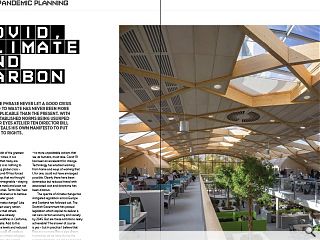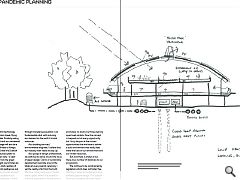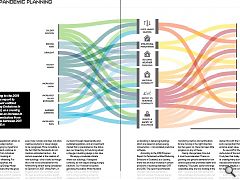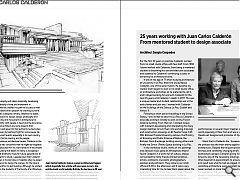Post-Pandemic Planning: Covid, Climate & Carbon
15 Oct 2020
The phrase never let a good crisis go to waste has never been more applicable than the present. With established norms being usurped before our eyes Atelier Ten director Bill Ritchie reveals his own manifesto to put the world to rights
As we sit in the midst of the greatest global crisis of our times, it is a sobering thought that many are predicting that this is as nothing to the next impending global crisis – climate change. Covid-19 has forced us to behave in ways that we thought previously were unimaginable – staying at home, wearing a mask and even not seeing your loved ones. Terms like ‘new normal’ have conditioned us to behave in ways for the greater good.
But what of climate change? Like Covid-19 it will affect every nation. Some clearly more than others.
This year we have already witnessed record wildfires in California, Oregon and Australia. Add to this droughts, rising sea levels and reduced agricultural yields could all create as many as 300 million climate refugees. Perhaps, just perhaps, the current pandemic is just a taster – a precursor – to more unpalatable actions that we, as humans, must take. Covid-19 has been an accelerant for change. Technology has enabled working from home and ways of working that I, for one, could not have envisaged possible. Clearly there have been downsides but reduced travel with associated cost and downtime has been a bonus.
The spectre of climate change has instigated legislation across Europe and Scotland has followed suit. The Scottish Government has passed legislation which aspires to deliver a net zero carbon economy and society by 2045. But are these ambitions really achievable? The answer of course is yes – but in practice I believe that they are no more than a pipe dream. In practice, as we have during the current pandemic, we will be required to behave very differently to the way that we do now. Until technology facilitates zero carbon travel, flying will be unacceptable. Similarly eating meat will be taxed and our unmetered domestic water usage will also be a luxury that we will need to forego. It was only in 2016 that the Scottish Government announced plans to scrap air passenger duty – a clear demonstration of how the green declarations and glib sound bites are railing against the stark realities of change. These harsh realities are not popular and clearly not vote winners! The reality is that capitalism as it exists now is unsustainable. Growth at all costs which drives our economy through increasing population is at fundamental odds with reducing our demand on the earth’s limited resources.
As a building services/environmental engineer, I believe that our industry now needs to step up.
As a group of design professionals, we continue to dance around the issue of green design. Claims of sustainable development resonate around the tables at every awards ceremony – yet the reality is far from the truth. We have come a long way in the last twenty years when I first started to promote sustainability. At that time, it was seen as a tree hugging ideology promoted, no doubt, by those wearing open toed sandals. Now the concept is traipsed out at every opportunity, but I truly despair at the missed opportunities that we have to deliver a built environment that really does make the best of our environment and our limited resources.
But, and there is always a but, there are a number of obstacles to our progression.
We continue to be constrained by legislation which does not foster free thinking or allow our buildings to truly embrace passive design. The Scottish Technical Standards and their rough means of compliance do not help us to promote low operational carbon or help reduce embodied carbon.
Despite lobbying by myself and others, the Standards continue to squeeze carbon from individual buildings without looking at opportunities for offsetting. For non-domestic properties, the Simplified Building Energy Model Compliance Software (the title gives it away) continues to promote sealed buildings, which are comfort cooled by unsuitable refrigerant based fan coils. For domestic buildings, the software is even more ‘simple’ and does not allow creative solutions or clever design to be recognised. More incredible, is the fact that the Standards do not mention embodied carbon – the carbon expended in the creation of new buildings - and it looks as though this is not to be considered for the forthcoming refresh being considered to Section 6 in 2021. Unlike Part L in England which was redrafted earlier this year to embrace passive design, our refresh will not catch up until 2024.
With our hands firmly tied behind our back through inappropriate and outdated legislation, and an investment market that is predicated on the status quo, our trajectory to truly bring about a change in building design is too slow.
We enjoy a moderate climate where our buildings, if designed correctly, do not require energy hungry solutions. Our Victorian ancestors got along fine before Willis Haviland Carrier came up with his invention and it is truly humbling to see my colleagues at Atelier Ten in the US, Manchester and in London leave us standing in delivering buildings which are based on actual energy consumption – not outdated predictive software.
According to the 2018 Progress Report to Parliament entitled Reducing Emissions in Scotland, as a country, there was an actual increase in carbon emissions in buildings between 2011 and 2016. The report recommends stronger new-build standards, a new non-domestic buildings energy policy, support for the Renewable Heat Incentive Scheme and reform of monitoring metrics and certification. All are moving in the right direction, but two years on, there has been little progress on any of these.
Clearly change takes time but it must be accelerated. There is a growing and genuine demand for low carbon space that promotes health and wellbeing. The public sector and large corporates alike are now looking at the post - covid era and anticipating that their employees and building users will want better than the same old, same old. What is exciting is that we can deliver this with the right legislation and a recognition that these solutions enhance asset value.
As we scoff at the architectural carbuncles of the sixties and seventies, I truly fear that today we are in danger of creating many buildings that will be ridiculed and redundant in a similar timeframe. Maybe a circular economy for designers and contractors - but not one for the environment.
As an industry, let’s start banging the drum for change –and let’s stop deluding ourselves.
|
|






